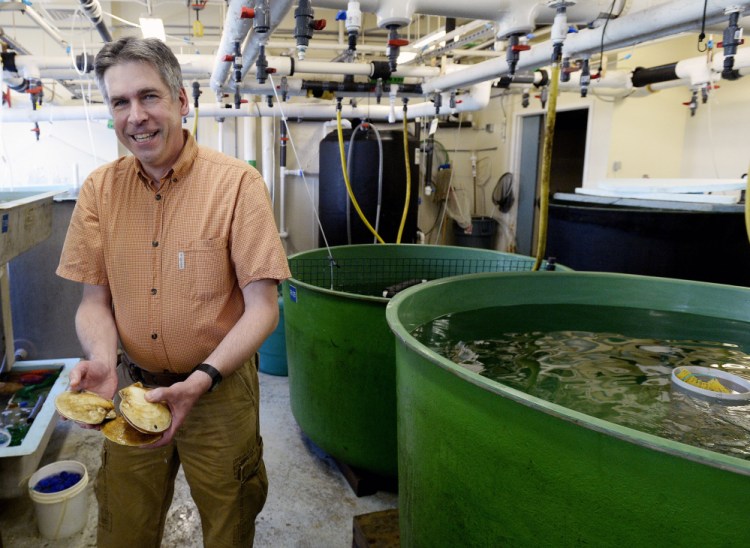Kevin Kelly has been at the Department of Marine Resources for almost 32 years, working on the groundfish and lobster fisheries before being assigned to scallops about nine years ago.
He’s very fond of the fishery and the tough souls who making a living from it during Maine’s toughest season. “It’s dwarfed by lobster of course, but to the people that do it is a really big deal, especially with the loss of some of these other fisheries,” he said referring to shrimp and groundfish. We called him up to talk methods, marine resources and menus.
DISSECTING HISTORY: Despite the expertise he’s developed, he’s not a scallop biologist. “My own kids probably think I sit at a desk and stare at scallops all day. But I deal more with the fishery and assessments than with the organism.” Was it part of his grand plan to spend his whole career at the Department of Marine Resources? He chuckled. “That was a long time ago. I can’t remember my plan.”
QUILTING SEA: The Department of Marine Resources divides sections of the coast into chunks, then divides the chunks into three pieces, which rotate through being open and closed to scallop fishing. It’s a patchwork mapping system. “We refer to it as the quilt,” he said. “The idea is to rebuild the resource and allow a certain amount of fishing to take place.”
When the department estimates that 30 percent of the harvestable biomass has been removed, the area is closed to give the scallops time to recover.
QUICK RECOVERY: It works, Kelly said. When Whiting Bay in Cobscook was closed in 2009, the harvestable biomass of scallops was about 8,000 pounds. “The first survey we did, a year later, the resource had already increased to 45,000 pounds.” After three surveys, it reached about 90,000 pounds. “Then it reopened, but under a controlled amount of fishing for the year.”
THE BIG PICTURE: Maine scallops have a great reputation for flavor and freshness, but on a national scale, the fishery is small potatoes. “We may land 600,000 pounds in a season and at the peak of the federal fishery, it was probably in the 50 million pound range.”
Maine scallops are special, though, in that scallops come to land and to the marketplace typically in a day; those massive hauls in the federal fishery are caught in federal waters, much farther out. “We’re really the only state that has a significant scallop fishery.”
INCONVENIENT TRUTH? We asked Kelly whether Maine scallops are showing any impact from climate change. There have been reports that scallops in the broader New England region could be affected, Kelly said, but no indication of an impact in Maine. Yet. “We don’t have any direct evidence that anything is really going on or has affected the amount of our scallops.” Scallops are found across a fairly broad range of temperatures, “as far south as North Carolina,” Kelly said. “So they can withstand warmer waters.” Some scientists fear that ocean acidification as a result of warming waters could affect survival of the shellfish in its larval stage, or its growth.
HOW TO: Just how does one survey scallops? To a certain extent, by imitating fishermen. Kelly said they catch scallops using a New Bedford-style drag equipped with 2-inch rings, half the size of the legal ones used by scallop fishermen; this way they’ll catch the smaller scallops so they can assess potential harvests.
Scallops do move, but not nearly at the rate fish do, so it’s possible to get a fairly accurate count for any given area. Unlike fishermen, the Department of Marine Resources sticks around in the areas where the scallops aren’t plentiful. “We can’t just survey the really good areas. We have to map out all the potential scalloping area.”
‘TIS THE SEASON: The surveys are usually done in the spring, with an eye toward predicting the size of the scallop population when the season opens in December. If an area does need to be shut down temporarily, the department has time to make the necessary management adjustments and to give fishermen advance notice.
“The only one we still do in the fall is Cobscook Bay,” Kelly said. “That is our most intensive survey.” That’s because Cobscook is the richest scallop ground in the state, and accordingly attracts the most boats (between 120 and 130 every season, Kelly said) and requires more regulation. “It has got more limits than other areas.”
UNTAPPED MARKETS: As Kelly points out, the only part of the scallop that is landed is the abductor muscle. The rest of the shellfish gets tossed at sea. “It is a lot of waste of the organism,” he said. It takes about 2,000 scallops to yield 90 pounds of scallops for the marketplace. One thing that could be salvaged from the waste is roe. “There is a tiny market for that,” Kelly said. “It’s not really my cup of tea.”
ON THE MENU: Does a scallop surveyor get sick of eating scallops? Apparently not. “I love almost any seafood, especially Maine scallops.” Favorite recipe? “Sometimes I will grill them or make something like a carbonara sauce. But more often than not, I’m just frying them with a little butter and caramelizing them a little bit. The key is not to overcook them.”
Send questions/comments to the editors.




Comments are no longer available on this story